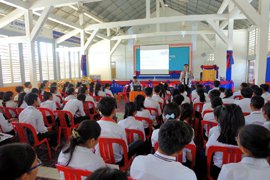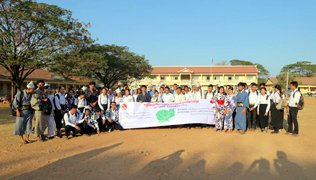Sakura Caravan for Popularizing the Japanese Language and Japanese Culture
Department of Japanese, Institute of Foreign Languages, Royal University of Phnom Penh
TACHIBANA Hidemasa
Cambodia’s Japanese-Language Education Situation
“Three years, eight months and 20 days.” Do you know that this number is?
It is a number most adult Cambodians are familiar with. It refers to the period (April 17, 1975 to January 7, 1979) during which the Khmer Rouge’s Pol Pot Administration controlled Cambodia. An estimated 1.5 million to 2 million people died during this period. Intellectuals, public servants and religious leaders were targeted in particular. The individuals who perished are understood to have included a large number of teachers, and education in Cambodia was interrupted as a result.
For this and other reasons, the history of Japanese-language education in Cambodia is shorter than it is in other ASEAN member countries. A Japanese-language course was established at the Royal University of Phnom Penh in 1993 with the cooperation of the Japan Overseas Cooperation Volunteers (JOCV). Accordingly, it could be said that Cambodia’s Japanese-language education is still in the process of being developed.
Because of the considerable economic disparity that exists between urban areas and other regions, Japanese-language education is mainly taking place in urban areas. In urban areas, the learners center on university students and working adults, while in regions where the ratio of students who continue on to university is low, the learners are mainly young people. Across Cambodia as a whole, beginner-level learners account for a large number of the learners.
What Is the “Sakura Caravan for Promoting Japanese Language Education and Culture”? (Hereinafter the “Caravan”)
In light of this situation, the “Caravan” is held with the goal of showcasing the Japanese language and Japanese culture, and increasing the number of Japanese-language learners. It is held every year in partnership with the Embassy of Japan in Cambodia and with assistance from The Japan Foundation. The ninth Caravan was held in February 2019.
The outline of the Caravan is as follows:
| Destinations | High schools within or around Phnom Penh City, regional high schools |
|---|---|
| Team structure | Five to six people in total: Three to four Japanese-language teachers (two to three Japanese nationals, one to two Cambodians), two to three students (Cambodians) |
| Schedule | Same-day (for high schools in or around Phnom Penh City), two nights and three days (for regional high schools) |
| Visiting time at one school | From two to two-and-a-half hours |
| Number of students | Around 80 to 100 |
| Program | (1) Video introducing the Japanese culture; (2) the recounting of students’ experiences studying abroad; (3) trying on Yukata (Japanese summer kimono); (4) Origami helmet-making; (5) explanation of scholarship; (6) questions and answers |
When visiting regional high schools, participants visit three schools over the two nights and three days. Thus far I have taken part in same-day Caravans, as well as two-night, three-day Caravans.
Reactions from Students
In some cases when the Caravan travels to regional areas, the students are seeing Japanese people for the first time. Consequently, in Part 1 of the program, the video introducing the Japanese culture, when the video begins their eyes light up and they watch it with keen interest. Cries of amazement go up when the video shows Shinkansen trains, Mt. Fuji and sumo wrestling.

Introducing Japan and the Japanese culture
In Part 2 – the recounting of students’ experiences studying abroad – many of the high school students listen attentively so as to not miss a word. They ask questions at the end of the program, and some of the questions that come up are as follows:
- I want to study the Japanese language, but is it difficult?
- How can I work in Japan?
- How long will I have to study Japanese before I become able to speak it?
- If I study Japanese, will I be able to earn a high salary?
- If I get sick while in Japan, what should I do?
- If I learn Japanese, what sort of jobs will I be able to do?
In Part 3 of the program – trying on a Yukata – around 10 boys and 10 girls are chosen to actually try on a Yukata. Because this takes time, during that period the remaining students are introduced to Origami helmet-making (Part 4). Squares of newspaper matching the number of students present are prepared, and everyone folds helmets according to an example. For many of the students, this is their first experience of Origami, so although this exercise takes a little time, everyone is smiling by the end.
While this is going on, the “trying on Yukata” exercise also ends, and the girls and boys form pairs to make their appearance. They are met with a round of loud applause. Some of the students hurriedly take photos. A lot of them also seem to be watching the Yukata-wearers enviously. If it was feasible we would like to give all the students the chance to try on Yukata, but the number of Yukata available is limited, and neither are there enough people capable of helping the students put them on, so we cannot offer it to everyone.

After the program has ended
Conclusion
We travel to the regions in a microbus, so it is very tiring, and after returning from a two-night and three-day Caravan, everyone is exhausted. Rail transport in Cambodia is not very well-developed, and the road conditions are not good either, so in some cases it takes more than six hours from Phnom Penh to reach high schools in regional areas. Additionally, because there is a report deadline, we have to collate the results of the student surveys we take as quickly as possible. We meet in the guesthouse rooms in the evening to do this, and when it is still not possible to get it done in time, we do it on the microbus while traveling.
There are thus a large number of points that we struggle with, but coming into contact with the students, who participate in the program with beaming faces, and realizing that some among them will become students studying the Japanese language in the future, also serves to lift our exhaustion. There are in fact some students from regional high schools that we have visited in the past who have gone on to study at the Department of Japanese, Institute of Foreign Languages, Royal University of Phnom Penh.
Obviously, there are budget considerations, but I hope this Caravan continues for as long as possible.
- What We Do Top
- Arts and Cultural Exchange [Culture]
- Japanese-Language Education Overseas [Language]
- Japanese-Language Education Overseas [Language] Top
- Learn Japanese-language
- Teach Japanese-language
- Take Japanese-Language Test
- Know about Japanese-language education abroad
- The Japanese-Language Institute, Urawa
- The Japanese-Language Institute, Kansai
- Japanese-Language Programs for Foreign Specified Skilled Worker Candidates
- Japanese Language Education for Japanese Children Resident Overseas and for the Descendants of Migrants
- Archives
- Japanese Studies and Global Partnerships [Dialogue]
- JF digital collection
- Other Programs / Programs to Commemorate Exchange Year
- Awards and Prizes
- Publications
